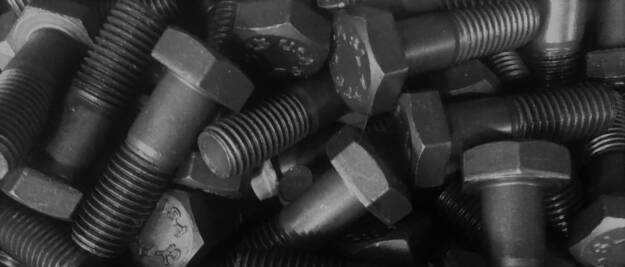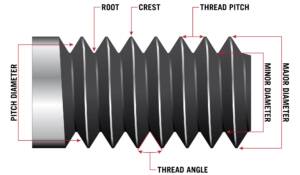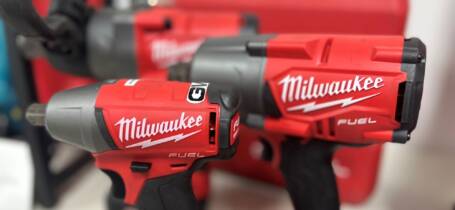
Choosing the correct thread pitch is crucial in mechanical engineering and manufacturing. While it might seem like a small detail, thread pitch has significant implications for the strength and reliability of threaded connections. This guide covers the basics of thread pitch, how to measure it and its applications to help you make informed decisions for your projects.
What Is Thread Pitch?
Thread pitch is the distance between threads on a screw or bolt. Measured in millimeters (for metric threads) or threads per inch (for imperial threads), it’s a key factor in the functionality of threaded fasteners. The pitch determines how far a bolt travels when turned 360 degrees and directly impacts the strength and stability of the connection.
The correct thread pitch ensures that parts fit together properly, providing the necessary tension and preventing loosening under stress. Incorrect pitch can lead to stripped threads, weakened connections and potential failure of the assembly.
The graphic below illustrates the key components of a thread, with the distance between the crest and root indicating the thread pitch.
Structural Bolts and Thread Types
Understanding thread pitch is crucial for selecting the right type of bolts for your project, especially when it comes to structural bolts. These bolts are vital in high-stress applications, such as construction and heavy machinery, where they play a significant role in maintaining safety and integrity.
Structural bolts are designed to handle substantial loads, making them indispensable for projects like bridges and buildings. They are engineered to break before stripping, which preserves the structural integrity of the assembly under extreme conditions. This feature is crucial in keeping connections secure, even when subjected to significant stress.
While structural bolts are critical in many applications, understanding different thread types — including UNC (Unified National Coarse), UNF (Unified National Fine), coarse thread, fine thread and 8-thread series — is also important. Here’s how they compare:
- Structural bolts: These bolts have specific thread designs that prevent stripping under high stress. The threads are typically coarse, which aids in quick assembly and provides better grip under heavy loads. Structural bolts are often made from high-strength materials to withstand significant stress and prevent failure.
- UNC threads: UNC threads feature wider spacing, making them suitable for quick assembly and high-wear applications. However, they are generally used in general-purpose applications and may not offer the same level of strength and resistance to stripping as structural bolts.
- UNF threads: UNF threads have a finer pitch, offering more threads per inch. This fine threading provides greater tensile strength and is suitable for precision applications where high stress is a factor.
- Coarse thread: Similar to UNC threads, coarse threads have fewer threads per inch, allowing for quick assembly and disassembly. They are commonly used in applications where speed and ease of use are important.
- Fine thread: Fine threads have more threads per inch, similar to UNF threads, providing a stronger hold and greater resistance to loosening due to vibrations. They are often used in precision applications that require a higher clamping force.
- 8-thread series: These threads are used in heavy machinery and structural applications requiring high load-bearing capacity. The 8-thread series combines the benefits of both coarse and fine threads, offering durability and strength for demanding environments.
Structural bolts are extensively used in the construction, automotive and manufacturing industries. Their robust design allows them to endure significant stress and provide reliable performance in critical applications, such as:
- Securing steel beams and other structural components in buildings and bridges
- Keeping components securely fastened in high-stress areas of vehicles, such as suspension systems and engine mounts, where strong, reliable connections are essential for safety and performance
- Maintaining the structural integrity of machinery and equipment where durability and strength are integral
How to Measure Thread Pitch in 5 Steps
Thread pitch is often listed in the product’s specifications or on its packaging. However, if you need to measure it manually, here’s a step-by-step guide to help you get accurate results.
To measure thread pitch, you will need:
- A thread pitch gauge: A tool with multiple blades, each labeled with a specific pitch size.
- Calipers: A precision tool used to measure the distance between threads.
Step-by-Step Guide
- Clean the threads: Ensure the threads are clean and free from debris for accurate measurement.
- Select the correct blade: Using the thread gauge, select the blade that matches the profile of the threads.
- Fit the blade: Place the selected blade into the threads. It should fit snugly without any gaps.
- Read the measurement: The number on the blade corresponds to the pitch size (in threads per inch or millimeters).
- Verify with calipers: For additional accuracy, use your calipers to measure the distance between threads. Place the calipers’s jaws on the crest of two adjacent threads and read the measurement.
The Importance of Thread Pitch in Real-World Applications
Choosing the right thread pitch ensures fasteners fit together precisely, providing the necessary tension and security. This is particularly important in high-stress applications such as construction, automotive and heavy machinery. Proper thread pitch selection helps maintain the integrity of structures and components, preventing failures that could lead to costly repairs or safety hazards.
Common Issues With Incorrect Thread Pitch
Using an incorrect thread pitch can lead to several problems:
- Stripped Threads: Threads that don’t match can strip easily, weakening the connection and potentially leading to failure.
- Loose connections: If the thread pitch is too coarse or too fine, the fastener may not hold securely, resulting in loose connections that can compromise the integrity of the assembly.
- Increased wear: Mismatched threads can cause increased wear and tear on the fasteners, reducing their lifespan and requiring more frequent replacements.
How does this impact real-world applications? In the construction industry, using the wrong thread pitch in structural bolts can weaken the entire structure, leading to potential collapses or the need for extensive repairs. In automotive applications, incorrect thread pitch in engine components can result in mechanical failures, posing significant safety risks.
Tips for Avoiding Issues
To avoid these problems, always:
- Consult specifications: Check the product specifications to ensure you are using the correct thread pitch.
- Double-check measurements: Measure the thread pitch accurately if there is any doubt.
- Use quality fasteners: Invest in high-quality fasteners that meet the required specifications for your application.
Thread Size Chart
Using the correct thread size and pitch ensures the strength and reliability of your mechanical connections. Refer to this chart whenever you select fasteners for your projects to ensure compatibility and performance.
How To Use the Thread Size Chart
- Identify the thread type: Determine whether you need coarse, fine, 8-thread series, UNC, UNF, metric threads, or structural bolts based on your project requirements.
- Find the diameter: Locate the nominal diameter of the bolt or screw.
- Check the pitch: Find the corresponding thread pitch for the selected diameter.
| Thread Type | Nominal Diameter | Threads per Inch (TPI) | Pitch (mm) | Applications |
| Coarse | ¼” | 20 | – | General-purpose, quick assembly |
| Fine | ¼” | 28 | – | High-stress, precision |
| 8-thread series | ½” | 8 | – | Heavy machinery, structural |
| Structural bolt | ½” | 13 | – | Construction, structural projects |
| UNC | ½” | 13 | – | Construction, automotive |
| UNF | ½” | 20 | – | Precision machinery |
| Metric | 12mm | – | 1.75 | Heavy-duty applications, manufacturing |
| Structural Bolt | ¾” | 10 | – | Heavy machinery, structural |
| Coarse | ¾” | 10 | – | Heavy machinery, structural |
| Fine | ¾” | 16 | – | Precision instruments |
| Metric | 20mm | – | 2.5 | Industrial applications |
| Structural Bolt | 1″ | 8 | – | Major construction, bridges |
Moving Forward With the Right Thread Pitch
Whether you are working on large-scale construction, automotive applications, or precision machinery, using the right thread pitch ensures strong and reliable connections.
Ensure the success and safety of your next project by choosing the correct thread pitch and bolts. Visit our resource page for more detailed information, charts and tools. Contact GWY today for expert advice and to explore our wide selection of structural bolts and other fasteners.




